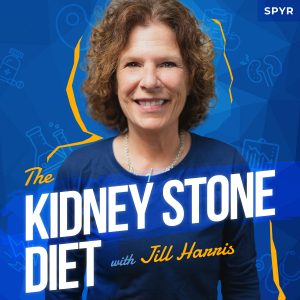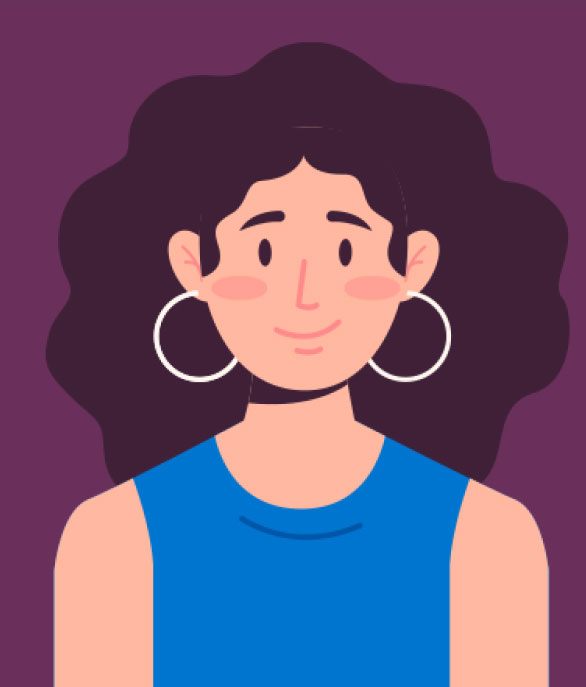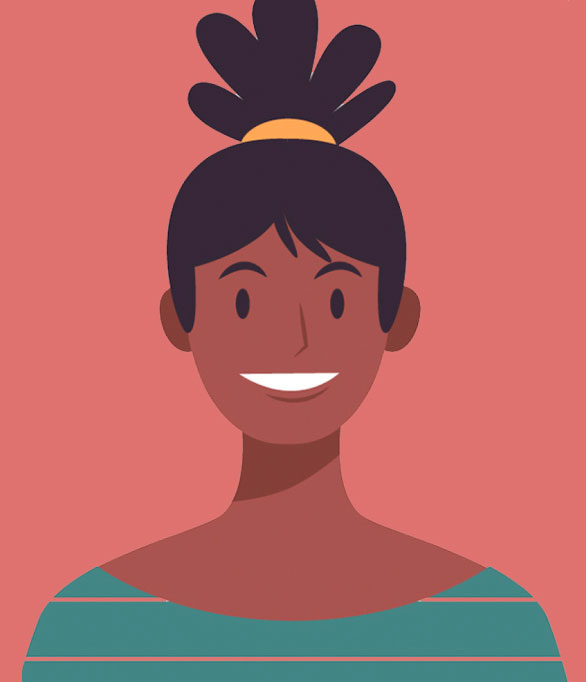This week on the Kidney Stone Diet Podcast, Jill Harris answers a frequently asked question about vitamins and our kidneys.
Jeff Sarris: Welcome back to the Kidney Stone Diet podcast, the show about reducing your kidney stone risk and living your best life. I’m your host and fellow student, Jeff Sarris.
Jill Harris: And I’m Jill Harris, your kidney stone prevention nurse. I’m so happy to be here. Oh, look, Jeff, look what I got! Somebody bought me this. You know, I always have my rock and roll chain here, but somebody bought me this. And for you guys on Spotify, it’s a little uh…
Jeff Sarris: Ah, it’s a paw print!
Jill Harris: It’s a paw print of Luke’s paw. You download a picture of his paw and then they put it on a little uzi, and then his name is on the other side, Luke.
Jeff Sarris: Oh, that’s great. I love that.
Jill Harris: Yeah, I love it. It’s so sweet. And then did I show you my tattoo of Luke?
Jeff Sarris: No! Oh, that’s awesome. So I noticed–I’ve noticed it there and I was trying to figure out–
Jill Harris: Isn’t it amazing how good it is?
Jeff Sarris: It is so good. I was trying to figure out if that was new, but from a distance I didn’t realize it was Luke. Yeah. I love that. When did you get that?
Jill Harris: I got it on his 10th birthday. He was dead by that point. So, he died a few days before his 10th birthday and I’ve been like, “I need a new tattoo.” And my mom, every time I see I’m like, “Ma, I need a new tattoo.” So, when he died, I’m like, “There’s my new tattoo.” And so I go to the same–I went to my guy, and he’s just–he really is an artist–and he said, “What’s what’s going on?” He said, “Luke died?” I said, “Oh, honey, he died.” He said, “We’ll do him right.” And oh my god, I love it so much. I could cry. And I know some of you who are my age, they’re like, “Oh, she’s got tattoos. What’s wrong with her?” I love my tattoos because they mean so much to me.
And this Luke tattoo, forget about it. He did such a great job. I’m like, “Well, you did him justice.” So Luke died on November 23 and then his birthday was December 2, and he would have been 10. So I’m like, on his birthday, the guy didn’t have time. He said, “Jill, I’ll move things around. I got you in on his birthday.” He’s such a big, like, guy like this. And he’s the mushiest, sweetest thing in the world. And so he got me in and it was one of the happiest days of my life, believe it or not, because I love tattoos. And that one forget about it.
Awesome. I love it. And how many how many total tattoos do you have?
1, 2, 3, 4, 5.
Jeff Sarris: Nice!
Jill Harris: Yeah, five of them. This one– hence my Dolly shirt–this one I got a Nashville. Once I started feeling better, that was one of my first trips I went on besides New York and my cancer treatments, and I got to horseshoe because I was in Nashville, but also because I just finished on my cancer stuff and with stage four cancer, you get to go to Nashville. You’re pretty freakin’ lucky. So I went to–Pink’s husband, Corey Hart, has a tattoo parlor there–because I love Pink, so I went to his tattoo parlor and they hooked me up with my little horseshoe.
So that’s one. And then I have an ankle one with a tree. And my little boy under the tree, which is my son. And then I have, you know, my birds, and then I have one from like, when I was 20, Calvin and Hobbes, just Calvin. I don’t ever see that one. Thank God it’s on my shoulder. Anyway, so, I have five now. I’m sure I’ll get more. It just has to mean something to me, you know?
Jeff Sarris: Yeah, that’s the big thing. It’s not just frivolous. Like, “Oh, let me do this ’cause I’m bored.” But there’s a reason behind it.
Jill Harris: Yeah, most of the time. I mean, let’s just say I was 20 or 19 with the Calvin one, so there’s no meaning behind that.
Jeff Sarris: Yeah, yeah, that first one maybe but yeah.
Jill Harris: You live and you learn!
Jeff Sarris: I love that Luke is right on your forearm. I always thought that’s a really good spot. Like something that’s meaningful, you you see that that’s there right in front of you all the time.
Jill Harris: Every time I’m lifting my weights. I’m like, “Hi, baby. Mwah!” Every time. It’s Wonderful.
Jeff Sarris: Well, I guess we should dive into this week’s topic.
Jill Harris: Oh, what are we here for?
Jeff Sarris: It’s tattoo hour, right? This is what we’re–big surprise! Someone’s coming in for a new tattoo. We’ll just have a live, like, sketch show going on all the time. So we’re gonna take another listener voicemail. The number again is 773-789-8763 if you have a question, but let’s dive into this week’s question here.
Listener Voicemail: Hi, my name is Sabine and I’m calling from Mississauga, Ontario, Canada. And I’d like to know if Jill can talk about some other type of kidney stones, like calcium phosphate, and how does oxalate affect the calcium phosphate stone? And is there any information she can give us to prevent calcium phosphate stones? That would be great. Talk to you later. Bye.
Jill Harris: Sabine. Sabine is from Canada?
Jeff Sarris: Yeah from Mississauga? I don’t know, like, she said it, but yeah.
Jill Harris: Wonderful! So, Sabine from Canada. So, many people will think, “God, she’s always talking about calcium oxalate.” The Kidney Stone Diet is for all stones, people. All stones, all stones, every single stone. Many people come to me with just calcium phosphate stone so the Kidney Stone Die will help all stones: uric acid, calcium phosphate, calcium oxalate. We talk about, we verbally say the word calcium oxalate lots of times because 80% of stone formers are. So my phosphate stone formers are like “Knock, knock, girl. We’re here.” I know. I see you. The Kidney Stone Diet is for all stones. That’s what all the goals are for. It will help all of you. I don’t think we make that clear enough. That’s why there’s a question about it.
When somebody has a question about something, I take it as I have not done a good job educating them because they should know that, right? Because that’s why I’m here. So I always like it when someone’s like, “Hey!” So, that tells me pay attention more. So calcium phosphate stones, they are trickier. They are trickier. They grow faster, they grow larger. So they are a trickier stone for sure. Many times, they are a calcium problem. Many times these patients will have a higher pH and these patients will say to me, “Well, what can I do to get that down?” You can’t. You can’t lower a pH. You can’t. So all the aspects of the Kidney Stone Diet are going to help you: lower your sugar–your added sugar–, lower your salt. That will help the excess calcium that’s coming out of your urine–out of your bone, I’m sorry.
Why Is Calcium So Important on the Kidney Stone Diet?
“Okay, Jill, does that mean–” this is very common– “Does that mean I don’t have to worry about oxalate?” A lot of people will say “Yeah!” That doesn’t mean you have to worry about oxalate. Please pay attention to what I’m going to say next, please pay attention because not everyone agrees with this. Many patients will say, “I was told I don’t ever have to worry about oxalate.” And I’ll say this, “I’m just a little, tiny baby nurse. I don’t know. But I’m just telling you from one gal pal to another, or one gal pal to a boy pal, I’m just telling you this: when you tell somebody that the next thing you know, they’re eating all kinds of spinach and almonds.” So even though somebody may have said, “Hey, your oxalate’s low!” That’s not the problem.
It wasn’t on that day of the urine collection, perhaps, because you were extra good that day, because you didn’t want to catch what-for from the doctor. But if somebody tells you, your oxalate’s fine, I’m telling you what people do. And the next day people get up and they’re like, “I don’t gotta worry about oxalate. Bring on the spinach salad! Lots of them.” That’s what happens. And then the next time they have a kidney stone, it’s a mixed stone or 100% calcium oxalate because you already have the calcium issue going on; an abundance of calcium. And so, often, the abundance of calcium will have you make either calcium phosphate stone or calcium oxalate stone or mix. That’s why calcium is so important.
Keeping it in your bone and getting enough to eat every day. Even though people want to focus on oxalate, and dear Sabine, I can’t tell you how many times I say throughout the day, “Kidney stones is more of a calcium issue for patients than it is oxalate.” Actually, the oxalate part of this lifestyle bores the hell out of me, unless it’s somebody with malabsorption issues. Why do I say that? Because once you take away spinach and almonds and you get enough calcium every day, you don’t ever have to worry about oxalate again, unless you have malabsorption issues. You stop eating the highest oxalate foods in whatever amount you want; get your calcium; and you won’t have an oxalate problem. Does that mean, you can then if you don’t have a problem one day on your urine collection results, resume eating the spinach and almonds? No, it does not mean that. So I want to say that.
What Should a Calcium Phosphate Stone Former Pay Attention To?
So for calcium phosphate stone formers, you have to pay attention to a few things. You may have to go on medications to change the amount of calcium in your urine. If it does not lessen by getting rid of salt and sugar–added sugar, okay? You have to get enough fluids. You have to maybe even get a little bit more fluids than the average stone former–you should be peeing out two and a half to 3 liters. If I was a calcium phosphate stone former, I’d be really paying attention to the three liter mark because you’re trying to out-pee that high pH. A higher pH is one of the biggest indicators for why you’re getting calcium phosphate stones. Meaning, that’s not helpful in your situation, but we won’t care about a high pH if the patient is drinking enough fluids that will minimize risk still.
So some people will say, “Well, what the hell, Jill, you’re telling me I can’t do nothing about this pH. So I’m doomed?” No, keep your fluids up. That will counterbalance the part of the pH part that you can help. So do your work there. We won’t care about that pH. Make sure you’re working with someone that can help you keep calcium in your bone. For some reason you’re making calcium phosphate stones, or combination. You may have MSK which is medulla Larry sponge kidney that’s common with calcium phosphate stones. So there’s there’s different reasons, but the kidney stone guide helps you just as much as it helps calcium oxalate stone formers. uric acid stone formers as well. It’s a little bit more common for the phosphate and uric acid stone people to always adhere to the diet, but also they may or may need medications as well for their particular issues. But please heed my warning.
And you see, I get real serious because of what I see. I’m telling you, I’m shutting off my life. Hold on people. That’s it. I’m telling you to heed my warning because of what what I have seen. And people will say I was told not to worry about obsolete, so they go back to eating spinach. And the next one they have is a calcium oxalate stone. Meanwhile, they’ve made phosphate stones or uric acid stones their whole life. I’m a nurse, I don’t override a doctor’s order, so I will tell a patient, “I heard what you’ve been told. I’m just educating you and having you think outside the box.” And maybe you go back to the doctor and say that, just so you know, does this mean I can eat as much spinach as I want? Most of them will say no, but the orders were not clear. I’m lucky enough that I see that I talk to patients longer.
And then I also see follow-up patients. I hear what happened while I was making calcium phosphate stones, my doctor said or whoever said not to worry about oxalate, so I went to eating spinach again. Now I have a calcium oxalate stone. So I just gently explain or educate the patient that it didn’t mean that you could have as much spinach as you want. So again, it’s always about that for people. When we get the green light for something, especially a healthy food, we think more of it is better. So calcium phosphate stone formers, unfortunately, your issues can be a little bit more complicated.
Make sure you’re with a good doctor, whether that’s your urologist who is well versed, or a nephrologist, and please do follow the Kidney Stone Diet. It’s for all stone formers. For calcium phosphate stone formers, they tend to make bigger stones and they grow faster so it’s even more important for you to hear more days than not the dietary guidelines. We’re asking you the goals from the Kidney Stone Diet that you can find nice pretty infographic free, of course, at kidneystonediet.com/start. Our start page there and there’s all kinds of free information.
And if you need more specific questions on calcium phosphate stones, feel free to ask, but you are to follow the Kidney Stone Diet. That does not give you free rein to eat as much oxalate as you want. I’m not personally a believer in that. And I never really think that’s what the doctor intended to say. When you do urine collections, you’ve got to remember that we are looking at what you did for that day. So when I look at someone’s urine collection, I’m always like, I get it out. I’m like, “Okay, I see you peed five liters. Is this what we do every day?” “Well, Jill, no.” Because I know, look, if you’re a stone former you ain’t peeing five liters every day. That’s not part of your life. And especially if it’s the patient’s first stone. They weren’t drinking five liters and then they made a kidney stone. Usually they drank one liter, and that’s why they made a stone.
So when I’m going over a urine collection, I’m always like, Pepper Anderson Dickinson, policewoman, okay? I see these values, but let’s talk about what’s real life and what’s full do because it’s not to shame a person is to see what am I really working with? Because I need to educate a person that, if they don’t know, they don’t know. Or if they’re doing a collection because their home with COVID right now, they have time to go to the bathroom. They know the doctor is going to look at the report. They want to be a great student. They want to do what they were told. The urine collection is a one-day look on your life. It’s not a “Okay, this is perfect. Now you’re clear, and you’re never going to make a stone again.” You will if you go back to your old lifestyle habits, so we’ve gotta be clear. We’ve got to be honest with what we’re doing on the day of the urine collection. Does that make sense, Jeff?
Jeff Sarris: Yeah, it definitely does. I mean, because we all want to pass the test. We all want to do the best we can if it’s in school memorization, or whatever it is. Yeah, it’s sort of along those same lines that we’re trying our best to, to look– it’s like brushing your teeth really thoroughly before the dentist. And it’s like, yeah, it’s great, but what about the other day? Yeah, I think that’s wonderful. And then again, the urine collection and all these things, you can dive deeper at kidneystonediet.com. And if you have any questions, the number is 773-789-8763. But yeah, we appreciate everyone listening, everyone watching, everyone who’s called in. We still have more questions on the way some FAQs, everything. This is this is a neverending topic. So, every time we share it with a loved one or anything, it really helps because we’re trying to reach as many people as we can and get all of this information out there because it’s so important.
Jill Harris: Yes, and the Kidney Stone Diet is great for anything you’re battling. I mean, a lower sugar, lower salt diet, if you just need to lose weight. I work with a lot of people who just need to lose weight. You know, I’ve referred patients for that. And also if you need to maintain weight, you may need a conversation, too. There’s plenty of things on my website free at kidneystonediet.com the blog if you’re trying to gain weight as well.
Jeff Sarris: So that’ll do for this week. Thanks again for watching and we will see you next time.
Jill Harris: Thanks, guys! Thanks, Sabine!














Leave a Reply